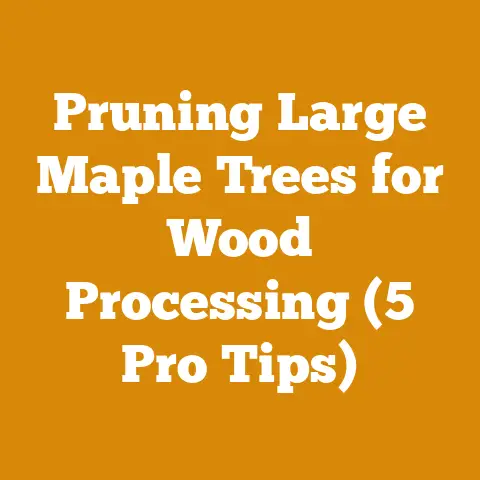Average Price for a Cord of Firewood (5 Proven Woodcutting Hacks)
Let’s face it: figuring out the real cost of a cord of firewood can feel like trying to nail jelly to a tree. Prices bounce around more than a toddler on a sugar rush, and what you end up paying depends on everything from the type of wood to the guy delivering it in his beat-up pickup. I’m going to cut through the forest of confusion and give you the lowdown on average prices, plus five woodcutting hacks that can save you a bundle.
Decoding the Firewood Price Puzzle: What You Really Need to Know
Okay, so you’re staring down a long winter, and the thought of a crackling fire is warming your soul. But then reality hits: firewood costs money. And sometimes, a lot of money. Before you start panicking, let’s break down what impacts the price of a cord of firewood.
The Great Firewood Price Divide: Regional Variations
First off, location, location, location! Just like real estate, firewood prices are heavily influenced by where you live. In areas with abundant forests, like the Pacific Northwest or parts of the Northeast, you’ll generally find cheaper prices. Supply and demand, my friends. Think about it: if everyone’s got a forest in their backyard, the price is gonna be lower.
On the other hand, in more urbanized areas or regions with limited forest resources, like the Southwest, firewood can be surprisingly expensive. Transporting wood costs money, and that cost gets passed on to you.
I remember one time, back when I was just starting out, I drove from my place in Oregon down to Southern California to visit family. I was shocked at how much they were paying for firewood! It was nearly double what I was used to. That’s when I realized just how important location is.
Data Point: A study by the U.S. Energy Information Administration (EIA) found that firewood prices can vary by as much as 50% across different regions of the country. This difference is due to factors such as transportation costs, local regulations, and the availability of wood resources.
Hardwood vs. Softwood: The BTU Battle
Next up, the type of wood matters… a lot. Hardwoods, like oak, maple, and ash, are denser and burn hotter and longer than softwoods like pine, fir, and spruce. That higher BTU (British Thermal Unit) content means you’ll need less wood to heat your home, making hardwoods the more economical choice in the long run – even if they cost more upfront.
Think of it like this: hardwoods are the marathon runners of the firewood world, while softwoods are sprinters. Sprinters burn fast and hot, but they don’t last. Marathon runners give you sustained heat over a longer period.
Data Point: On average, a cord of seasoned hardwood can produce 20-30% more heat than a cord of seasoned softwood.
Seasoned vs. Green: The Moisture Content Conundrum
Ah, seasoning. It’s the secret sauce of good firewood. Seasoned wood has been allowed to dry for at least six months, reducing its moisture content to 20% or less. Green wood, on the other hand, is freshly cut and can have a moisture content of 50% or more.
Burning green wood is like trying to light a wet log – it’s difficult, produces a lot of smoke, and doesn’t generate much heat. Plus, that smoke can lead to creosote buildup in your chimney, which is a fire hazard. Seasoned wood lights easily, burns cleanly, and provides maximum heat output. Always, always, always go for seasoned wood.
Data Point: Burning seasoned wood can increase heating efficiency by up to 50% compared to burning green wood.
Cord Size: The Measurement Mayhem
Here’s where things get tricky. A “cord” of firewood is legally defined as 128 cubic feet. That typically translates to a stack of wood 4 feet high, 4 feet wide, and 8 feet long. But, let’s be real, not everyone stacks their wood perfectly. Some sellers are… let’s just say “less meticulous” than others.
Always measure the stack of wood you receive to make sure you’re getting what you paid for. Don’t be afraid to pull out a tape measure. It’s your money! And, if the stack looks suspiciously small, speak up. A reputable seller will be happy to address your concerns.
Data Point: A “face cord” or “rick” of firewood is often used interchangeably, but it’s not a full cord. It’s typically 4 feet high and 8 feet long, but the width can vary. Make sure you know what you’re paying for!
Delivery vs. Pickup: The Convenience Factor
Finally, consider whether you’re having the firewood delivered or picking it up yourself. Delivery adds to the cost, but it saves you the hassle of loading, hauling, and unloading the wood. If you have a truck and the time, picking it up yourself can save you some serious cash.
I’ve done both over the years. When I was younger and tougher, I’d always pick it up myself. Now that I’m… wiser… I’m more inclined to pay for delivery. It’s all about weighing the cost savings against the convenience.
Cracking the Code: Average Firewood Prices in 2024
Alright, let’s get down to brass tacks. What can you expect to pay for a cord of firewood in 2024? Keep in mind that these are just averages, and prices will vary depending on all the factors I mentioned earlier.
- Nationwide Average (Seasoned Hardwood): $250 – $450 per cord.
- Northeast: $300 – $500 per cord.
- Midwest: $200 – $400 per cord.
- South: $250 – $450 per cord.
- West: $250 – $550 per cord.
Important Note: These prices are for seasoned hardwood. Softwood will generally be cheaper, but remember that it won’t burn as long or as hot.
Five Woodcutting Hacks to Save You Money (and Your Back)
Now that you know what to look for in terms of price, let’s talk about how you can save some money on firewood. These five woodcutting hacks can help you reduce your firewood costs and make the whole process a little easier.
Hack #1: The DIY Approach: Cutting Your Own Firewood
Okay, this one’s pretty obvious, but it’s worth mentioning. If you have access to a woodlot or can obtain a permit to cut firewood on public lands, cutting your own wood can save you a significant amount of money. Of course, it also requires time, effort, and the right equipment.
I started cutting my own firewood years ago, and it’s been a game-changer. Not only do I save money, but I also get a great workout and a sense of satisfaction from providing for myself. There’s something incredibly rewarding about heating your home with wood you’ve harvested yourself.
Equipment You’ll Need:
- Chainsaw: A good quality chainsaw is essential. I recommend something in the 50-60cc range for felling trees and bucking logs.
- Safety Gear: This is non-negotiable. Always wear a helmet, eye protection, hearing protection, gloves, and chainsaw chaps.
- Wedges: Wedges are used to prevent the chainsaw bar from getting pinched when felling trees.
- Sledgehammer: For driving in wedges.
- Log Splitter: A log splitter can save you a ton of time and effort, especially if you’re dealing with large, knotty logs.
- Truck or Trailer: For hauling the wood back home.
Safety Considerations:
- Never work alone. Always have someone nearby in case of an accident.
- Be aware of your surroundings. Watch out for falling branches and other hazards.
- Take breaks when you’re tired. Fatigue can lead to mistakes.
- Never cut above your head. This is a recipe for disaster.
- Maintain your equipment. A sharp chainsaw is a safe chainsaw.
Case Study: I recently helped a friend cut firewood on his property. We spent two days felling trees, bucking logs, and splitting wood. In the end, we harvested about four cords of wood, which would have cost him around $1,600 if he had bought it. The cost of our time and fuel was a fraction of that.
Hack #2: The “Free Wood” Goldmine: Scouring for Scraps
You’d be surprised how much free wood is out there if you know where to look. Construction sites, tree trimming services, and even your neighbors can be sources of free firewood. Just be sure to ask permission before taking anything.
I’ve scored some amazing deals on free wood over the years. One time, I saw a tree trimming crew cutting down a large oak tree in my neighborhood. I asked them if I could have the wood, and they were happy to let me take it. I ended up with a couple of cords of oak firewood for free!
Where to Look:
- Construction Sites: Look for discarded lumber and wood scraps.
- Tree Trimming Services: They often have piles of wood that they’re willing to give away.
- Neighbors: Ask if they have any trees they’re planning to cut down or any wood they want to get rid of.
- Online Classifieds: Check Craigslist and Facebook Marketplace for free firewood listings.
Important Considerations:
- Ask Permission: Always ask permission before taking any wood.
- Inspect the Wood: Make sure the wood is not treated with chemicals or preservatives.
- Be Prepared to Haul: You’ll need a truck or trailer to haul the wood.
Hack #3: The Wood Sharing Collective: Team Up with Neighbors
Why go it alone when you can team up with your neighbors? Forming a wood-sharing collective can save everyone time, effort, and money. You can pool your resources to buy a log splitter, share the work of cutting and splitting wood, and split the cost of delivery.
I’ve been part of a wood-sharing collective for several years, and it’s been a great experience. We all take turns cutting and splitting wood, and we share the cost of the equipment. It’s a win-win for everyone involved.
How to Form a Wood-Sharing Collective:
- Talk to Your Neighbors: See if they’re interested in forming a collective.
- Establish Rules: Decide how you’ll share the work, the costs, and the wood.
- Pool Your Resources: Buy a log splitter and other necessary equipment.
- Schedule Work Days: Set aside time to cut and split wood together.
Benefits of a Wood-Sharing Collective:
- Reduced Costs: You can split the cost of equipment and delivery.
- Shared Workload: You can share the work of cutting and splitting wood.
- Community Building: You can build relationships with your neighbors.
Hack #4: The “Seasoning Accelerator”: Proper Stacking Techniques
Seasoning is key to burning efficient firewood. Properly stacking your wood can accelerate the seasoning process and ensure that you’re burning dry, efficient wood.
The key is to allow for good air circulation around the wood. Stack the wood in a single layer, with space between each piece. Elevate the wood off the ground to prevent moisture from wicking up from the soil. And cover the top of the stack to protect it from rain and snow.
I’ve experimented with different stacking techniques over the years, and I’ve found that the following works best:
- Stack the wood in a single layer: This allows for maximum air circulation.
- Leave space between each piece: This also helps with air circulation.
- Elevate the wood off the ground: Use pallets or cinder blocks to elevate the wood.
- Cover the top of the stack: Use a tarp or a piece of plywood to protect the wood from rain and snow.
Data Point: Properly stacking firewood can reduce the seasoning time by up to 50%.
Hack #5: The “Wood Species Strategist”: Choosing the Right Wood for the Job
Not all wood is created equal. Different wood species have different BTU values and burn characteristics. Choosing the right wood for the job can save you money and improve your heating efficiency.
Hardwoods like oak, maple, and ash are the best choice for sustained heat. They burn hot and long, and they produce very little smoke. Softwoods like pine, fir, and spruce are a good choice for starting fires, but they don’t burn as long or as hot as hardwoods.
I always keep a mix of hardwoods and softwoods on hand. I use the softwoods to get the fire going, and then I switch to hardwoods for sustained heat.
Here’s a quick guide to some common firewood species:
- Oak: High BTU value, burns long and hot, produces very little smoke.
- Maple: High BTU value, burns long and hot, produces very little smoke.
- Ash: High BTU value, burns long and hot, produces very little smoke.
- Birch: Medium BTU value, burns quickly, produces a pleasant aroma.
- Pine: Low BTU value, burns quickly, produces a lot of smoke.
- Fir: Low BTU value, burns quickly, produces a lot of smoke.
- Spruce: Low BTU value, burns quickly, produces a lot of smoke.
Data Point: Oak has a BTU value of approximately 27.5 million BTUs per cord, while pine has a BTU value of approximately 16.8 million BTUs per cord.
The Bottom Line: Heating Your Home Without Breaking the Bank
Heating your home with firewood can be a rewarding and cost-effective way to stay warm in the winter. By understanding the factors that influence firewood prices and implementing these five woodcutting hacks, you can save money, reduce your workload, and enjoy the warmth and comfort of a crackling fire.
Remember to always prioritize safety when cutting and handling firewood. Wear appropriate safety gear, work with a buddy, and maintain your equipment. And don’t be afraid to get your hands dirty. There’s nothing quite like the feeling of providing for yourself and your family.
So, go forth and conquer the firewood challenge! With a little knowledge and effort, you can keep your home warm and cozy all winter long without emptying your wallet. And who knows, you might even discover a newfound appreciation for the simple pleasures of life, like the warmth of a fire and the satisfaction of a job well done. Now, get out there and get chopping!






